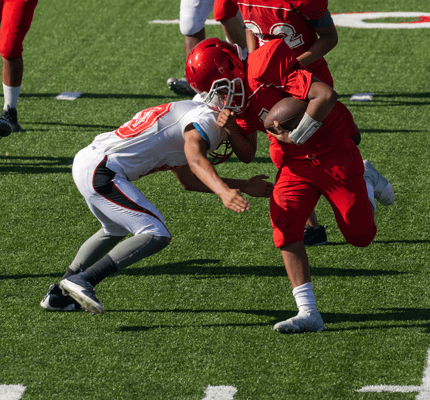
A Critical Look at CTE, “Brain Banking,” and Football
“Brain banking” refers to the practice of collecting brain tissue for analysis and study. In recent years, this practice has been particularly influential in publicizing connections between football and chronic traumatic encephalopathy (CTE), as CTE can only be definitively diagnosed after death. The vast majority of tissue samples donated to banks by former football players or their families have tested positive for CTE. At this point, it is unclear whether greater knowledge about the effects of football on players’ health will lead to the “end” of football or merely shift responsibility for players’ health onto players themselves. What is clear, however, is that current racial inequities in football will persist, and may worsen, through the CTE crisis. Black players are overrepresented at all levels of football and are thus disproportionately exposed to health risks associated with traumatic brain injury. In a new article published in NCA’s Communication and Critical/Cultural Studies, Daniel A. Grano examines the ways in which brain banking perpetuates racial inequities in football.
Race and Football
Grano argues that football is one example of how American institutions devalue Black life and health, often treating players as disposable objects. About 70 percent of National Football League (NFL) players are Black, and the percentage of white players in the sport has been declining in recent years. The NFL relies upon a talent pipeline that extends from youth football to college programs. Participation in youth football has been declining since 2010, in line with broader socioeconomic and racial inequities: white, advantaged families are increasingly opting out of the sport, while families of color weigh the game’s risks within contexts of limited economic and educational opportunity. Racial disparities in football are thus increasing as we learn more about the game’s harms.
A Brief History of Brain Banking and the Study of CTE
The collection of brain tissue began in the 17th century, but it was not until the early 2000s that doctors and scientists began studying deceased football players’ brains. In 2002, Bennet Omalu discovered deposits of tau, a protein associated with brain disease, during an autopsy of a former football player. The distinct pattern of tau accumulation became known as CTE. Omalu originally partnered with Chris Nowinski and formed the Sports Legacy Institute (SLI), but the partnership ended when Nowinski merged the SLI with the Boston University School of Medicine. Ann McKee, a lead researcher at the VA Boston Healthcare System, became involved and is now the most well-known researcher in this area. Because the SLI rebranded itself as the Concussion Legacy Foundation (CLF), the joint CTE brain bank is now known as the Veterans Affairs-Boston University-Concussion Legacy Foundation (VA-BU-CLF).
Some high-profile National Football League (NFL) players have died by suicide, prompting still-unanswered questions about the link between suicide and CTE. Some players have also explicitly demanded that their brain tissue be donated to the brain bank upon their death, as former Chicago Bears player Dave Duerson did in a suicide note. In response, the NFL has attempted to influence the collection and study of brain tissue by ensuring that only NFL-affiliated scientists have access to players’ brains. However, non-NFL-affiliated scientists at the VA-BU-CLF have managed to get access to some brain tissue samples for study.
How Football Devalues Players and Privatizes Risk
Although some people may think of football players as highly paid and, therefore, highly valued, the reality is somewhat different. Of the roughly 1 million high school football players in the US, only about 1.6 percent will make it to the NFL. Most professional football player careers are over within four years. Players later in their careers can be cut for rookies who earn a fraction of the salary for a veteran player. Because NFL contracts are not guaranteed, veterans routinely lose out on expected earnings.
Players of color are dehumanized throughout their careers, and their bodies are often represented in disposable or sacrificial terms. New forms of football fandom, such as fantasy football, treat players as objects to be “owned,” traded, and discarded. In sports journalism, players are often described using food-related terminology; for example, college prospects are depicted as “fresh meat” that NFL teams probe and evaluate. Food-based language has also been used to describe the process of studying players’ brains. Journalists explain the process by which “gelatinous” brain tissue is hardened so it can be sliced like pound cake or ham using a “tiny meat slicer” called a microtome. By analogizing the brain to a piece of food, CTE coverage represents racialized bodies as objects that can be disassembled, exchanged, commodified, and probed.
In addition to donations from deceased players, some living players have pledged their brains to brain banks. In contrast to actions such as donating blood, wherein one imagines a contribution to a broader social good, football players are pledging their brains with a more targeted community in mind. Grano argues that “rather than giving anonymously or for the sake of generalized collective values, players donate as members of a specialized risk pool, mindful of the potential benefits to people who they know or to whom they can relate.” CTE research thus shapes risk management as a private, rather than a collective or institutional problem: players emphasize that testing empowers them to make choices about their own health and careers; and fans may assume that athletes decide to play as an act of informed consent. These factors allow the NFL to address its own complicity in systemic health and racial inequalities (including labor exploitation and pseudoscientific denialism) in terms of a personalized relationship with players, rather than through the institution of structural reforms.
Conclusion
Greater awareness and advances in diagnosis of CTE do not mean that football will necessarily end. Grano argues that “‘death of football’ stories rarely imagine the total disappearance of the sport from US-American life. Rather, [the stories] raise questions about who will be left playing the game, and whether consumption of harm against those individuals’ bodies can be justified on revised moral, economic, and medical grounds.” The inequities around race and precarity that define the present and future of football cannot be addressed under the assumptions of informed choice fostered by CTE testing. Rather, risk, suffering, and harm to racial bodies must be understood as problems of collective obligation.


